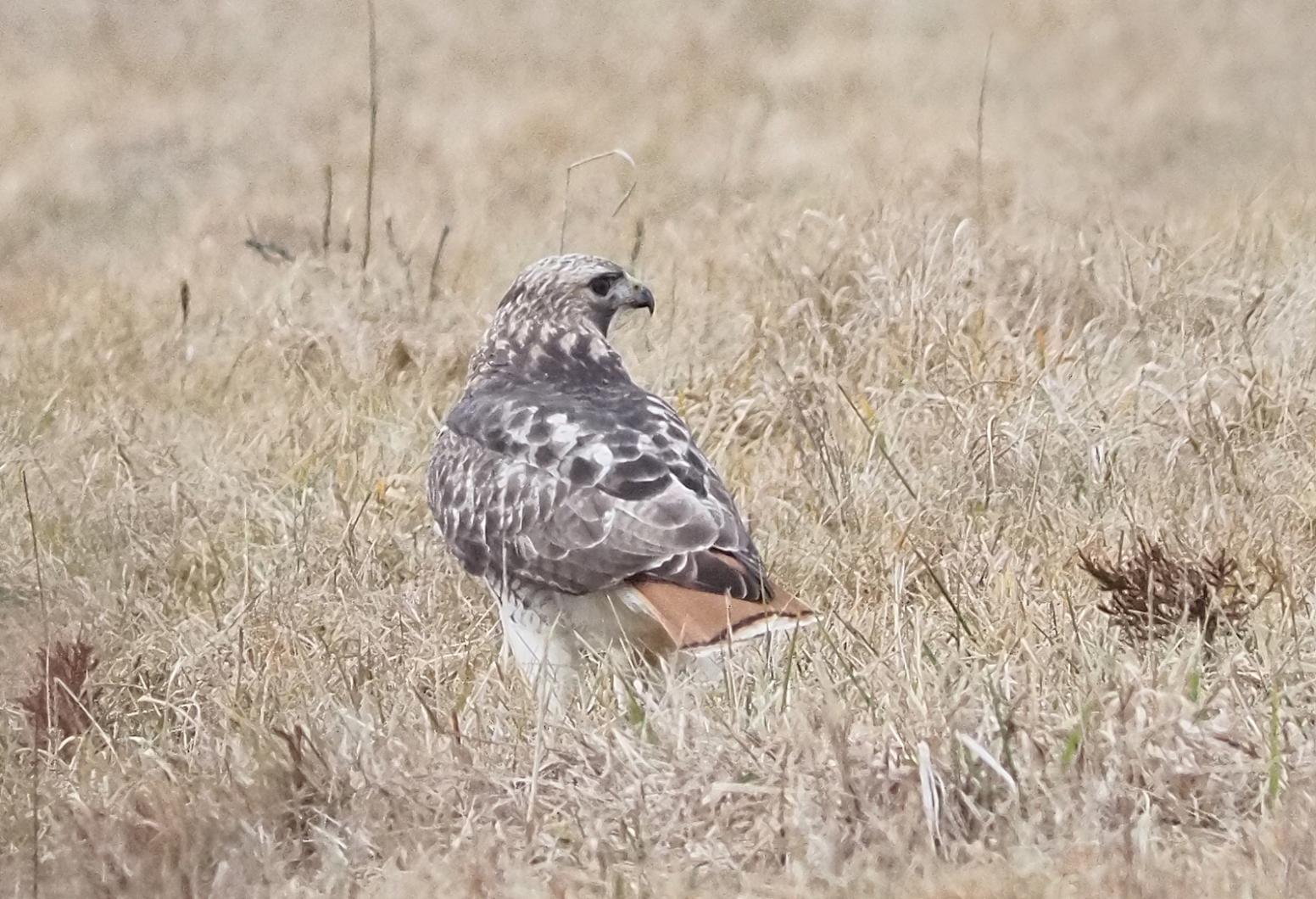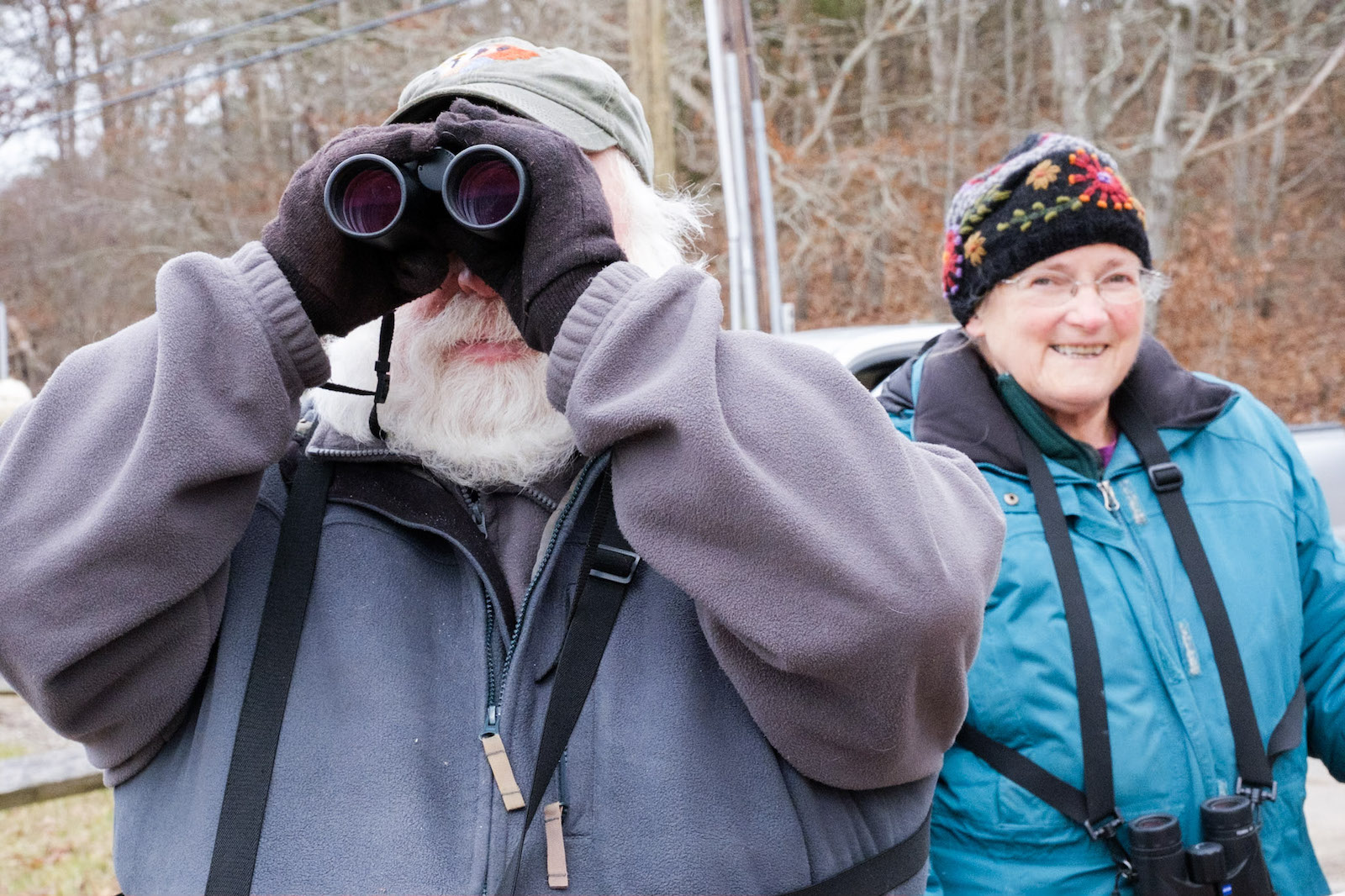The ducks were disappointing but the crows were having a good chat.
It was dark, a half hour before dawn, when Luanne Johnson made her first notation during Sunday’s annual Christmas Bird Count.
“First bird of the day is an audible, an American crow,” she said outside the entrance to Felix Neck, her ears attuned to what her eyes could not see. At the same time other birders were flocking in small teams — 13 in total — all over the Island for the annual event, which catalogs as many birds and species as it can during a 24-hour period.
“Second bird, a mourning dove,” Ms. Johnson said.
Another audible. “Nothing else has wings that sound like that, and it came up from the ground,” she explained.

The conditions were promising for the count, not too cold, not too windy and no fog. And yet for the most part the numbers at the start of the day were uninspiring. Ms. Johnson walked along the far edge of Sengekontacket Pond, checking the shoreline and marshes, but otter tracks and scat seemed more prevalent than movement in the skies.
Ms. Johnson is the director and wildlife biologist at BiodiversityWorks, the organization she founded in 2011. She is also the compiler and organizer of the Christmas Bird Count, which has taken place on the Island since 1960.
Its roots, however, date back much further, to 1900 when an officer of the nascent National Audubon Society named Frank Chapman decided an alternative needed to be created for the annual Christmas hunt, a practice where hunters tried to outdo each other in how many birds they killed on Christmas Day. His idea was to compile a list of birds sighted and left unharmed.
There were 27 teams that first count, mostly from California and Canada. Today, it is a international phenomenon and an essential tool for wildlife biologists, as the mountain of bird statistics compiled over more than a century tells the story of a shifting planet, from changing migration patterns due to global warming, to altered landscapes and territories.
The Christmas Bird Count takes place on a day within a window of a few weeks, from Dec. 14 to Jan. 5. Ms. Johnson chooses the actual day for the Vineyard count by narrowing it to a Sunday, when there is no hunting, and on a different day than many of the off-Island counts so some “ringers” from away can take part.
One of those ringers is Dave Small, a biologist who founded the Athol Bird and Nature Club among many other organizations. Mr. Small has a long white beard and hearty laugh but instead of leading a team of reindeer he has dedicated his life to tracking wildlife, and has participated in the Vineyard Count for decades. He said he became a birder as a young teenager, after being inspired by his junior high school science teacher.
“I compile dragonflies too,” he said, explaining there are more than 140 species of dragonfly and damselfly in Massachusetts alone. “And butterflies. I do butterflies too,” he added.
Mr. Small started the day birding along East Chop with his wife Shelley and Tom and Cathy Chase. His hat was emblazoned with a colorful illustration of a kestrel. He purchased the hat in Santa Anna, Tex. a few years back when birders of all sorts gathered there to catch sight of the rare bat falcon — a falcon that eats bats.
Mr. Small and Mr. Chase then reminisced about the year a red-footed falcon showed up in Katama, a European bird that had no business being here and so brought the wider birding community to Vineyard shores.
A bit of birdsong started up and the conversation stopped as the binoculars went up.
“Tufted titmouse,” Mr. Small said.
“And a yellow-rumped warbler,” Mr. Chase added.
Ms. Johnson jotted the species down on her eBird tally, which after a quiet start was beginning to grow.
Despite the communal atmosphere there is a bit of competition to the day, especially with other locations. The Cape and Islands, because of the region’s varied topography of wetlands and woodlands, usually leads the state in species, Ms. Johnson said.
“We always want to beat Nantucket but they get more rarities being further out to sea,” she said, recalling for example a magnificent frigatebird seen there a few years ago.
After a loop of the trails and shorelines around Felix Neck, the team decided to head to a new location, at upper Lagoon Pond, hoping for better luck.
While they walked to their cars Ms. Johnson’s phone lit up with a photo of a black-throated blue warbler seen that morning by Lynn Buckmaster-Irwin and Jim Irwin at a bird feeder.
The group cheered as it looked at the image.
“A male in full plumage,” Mr. Chase said in admiration.
Mr. Chase got turned onto birding by his great-grandmother, Florence Chase, when he was a child growing up in Oak Bluffs. He was later mentored by Gus Ben David.
“I came of age here at Felix Neck,” he said.
Then he made a career out of it, the retired director of the Islands Program for The Nature Conservancy still coming across as a gleeful student.
“There’s a special connection you get with birding,” Mr. Chase said. “It’s where the intellectual, meets the aesthetic, meets the social connection. You do it for decades and you build a community.”
He summed up the experience up with three words: “Beauty, brains, friends.”
The upper area of Lagoon Pond provided a windfall of black-crowned night herons which, as their name implies, are night birds and so at mid-morning were sound asleep, their beaks tucked beneath their wings while they roosted in large trees by the water’s edge. The group counted 47 individuals, all occupying various branches around the pond as if on some lazy stakout. Two great blue herons, day birds, flew by to show off their own impressive credentials.
Mr. Chase then spied an immature male Cooper’s hawk.
“Immature means it’s not of breeding age,” he explained, while pointing out its vertical stripes.
“When it comes of age horizontal stripes are added, which lets a potential mate know she’s not wasting her time.”
The Cooper’s hawk likes to eat songbirds and so hangs out low in the thickets. But it can also drop down to the ground and run its prey down, which it chose to do on this morning. The thickets shook but the action was out of sight.
And so it went around the Island, all day long, with some short breaks for food. In the evening the teams gathered at the Wakeman Center for lasagna and snacks, while getting down to the work of comparing notes. The tables were arranged in a horseshoe shape. Laptops were open and a big screen at the front of the room displayed a spreadsheet of the day’s results.
The Chappy team had some notables with a Wilson’s snipe and two red crossbills. Up in Aquinnah, the top find was a Tennessee warbler, a new species for the Christmas count day. The Quansoo team caught sight of a lesser yellowlegs, which is unusual for this time of year, and the Edgartown crew spotted an American kestrel.
The full list will take a few more days to compile, but by unanimous agreement it turned out to be a good day, although Gazette bird columnist Robert Culbert couldn’t believe he didn’t see a white-breasted nuthatch, one of the most common birds around here. But he did get a bald eagle around Tisbury Great Pond, which made up for it.
“And a common merganser and about 300 Bonaparte’s gulls,” he added.
For Ms. Johnson, the day started before dawn and later that night she would head out to try and find some owls. But the work got done and it was successful.
“We had 126 species and 30,000 individual birds sighted,” Ms. Johnson said. “That’s almost double the amount of birds from last year. We had more than 30 people in the field, and if you add feeder counts, that’s more than 60 people helping out. It was a tremendous effort and well worth it.”










Comments
Comment policy »